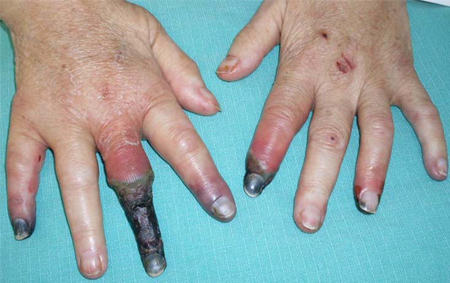Complications
Cases of hepatitis B reactivation have been reported during or after therapy with direct-acting antiviral agents.[97][124] It occurs more frequently in patients with chronic hepatitis B and hepatitis C co-infection compared to patients with resolved hepatitis B infection.[125]
All patients should be assessed for hepatitis B infection by testing for HBsAg, antibody to hepatitis B surface antigen (anti-HBs), and antibody to hepatitis B core antigen (anti-HBc) before starting therapy with direct-acting antiviral agents. Hepatitis B vaccination is recommended for all susceptible individuals.[66]
In patients who are HBsAg positive, a hepatitis B DNA test should be obtained prior to starting therapy. Patients who meet criteria for the treatment of active hepatitis B infection should be started on hepatitis B therapy at the same time as or before starting direct-acting antivirals. Patients with low or undetectable hepatitis B DNA levels should be monitored at least every 4 weeks for hepatitis B reactivation (with hepatitis B DNA) and, if hepatitis B DNA levels meet criteria for treatment, therapy for hepatitis B should be started.[66]
In patients who test positive for anti-HBs or anti-HBc, hepatitis B reactivation should be considered in the event of unexplained increases in liver enzymes during (or after) treatment with direct-acting antivirals.[66]
Only 2% to 20% of those chronically infected develop cirrhosis, usually over a period of approximately 20 to 25 years.[63] The risk of developing cirrhosis increases with the duration of chronic infection.
Patients with HIV co-infection and those who drink moderately or heavily may progress to cirrhosis much faster.
Hepatocellular carcinoma is typically only seen in those hepatitis C virus-infected patients with cirrhosis but can occur in patients without cirrhosis.[132]
The incidence in Western nations has increased in the past 2 decades, mainly because of the large pool of people with hepatitis C.[133][134]
Manifestations include abdominal pain, lethargy, or weight loss; alternatively, hepatocellular carcinoma may be discovered on radiographic imaging and be asymptomatic. It may be suspected in cirrhotic patients if they decompensate.
Statin use has been independently associated with a reduced risk of hepatocellular carcinoma in patients with hepatitis C virus infection.[135][136][137]
Hepatitis C virus infection is associated with an increased risk of cardiovascular disease.[138] Patients exhibit a higher prevalence of coronary artery disease and cerebrovascular disease. Presence of cirrhosis is directly associated with cardiovascular risk. Cardiovascular risk prevention strategies may be required.[139][140] Sustained virologic response after antiviral therapy was associated with an overall reduced risk of cardiovascular disease.[141]
Rheumatologic manifestations of hepatitis C include myalgia, fatigue, arthralgias, and arthritis.
Autoimmune manifestations include Sjögren syndrome.
Cryoglobulins are single or mixed immunoglobulins that undergo reversible precipitation at low temperatures. Cryoglobulins deposit in the skin, kidney, and joints. Patients may present with fatigue, arthralgias, peripheral neuropathy, palpable purpura, or glomerulonephritis.[128]
The most common variant in people with hepatitis C is type II (mixed) cryoglobulinemia. The likelihood of asymptomatic cryoglobulinemia is high, and that of symptomatic cryoglobulinemia is low.
There is limited evidence to support the use of rituximab in combination with antiviral therapy for the treatment of skin vasculitis and some laboratory findings. There is currently insufficient evidence to determine the best treatment strategy for this complication apart from antiviral therapy.[129]
[Figure caption and citation for the preceding image starts]: Unusual case of hepatitis C-related cryoglobulin-induced digital gangreneAbdel-Gadir A, Patel, K, Dubrey SW. Cryoglobulinaemia induced digital gangrene in a case of hepatitis C. BMJ Case Reports. 2010. [Citation ends].
The most common kidney disease related to hepatitis C infection is membranoproliferative glomerulonephritis, which may present with proteinuria, hematuria, and even edema, hypertension, and renal insufficiency.[130]
Eye manifestations include keratoconjunctivitis sicca (dry eyes), which may be a manifestation of Sjogren syndrome and Mooren ulcer (a rapidly progressive, painful ulceration of the cornea).[131] The diagnosis is made by exclusion of other causes of corneal ulceration.
Use of this content is subject to our disclaimer